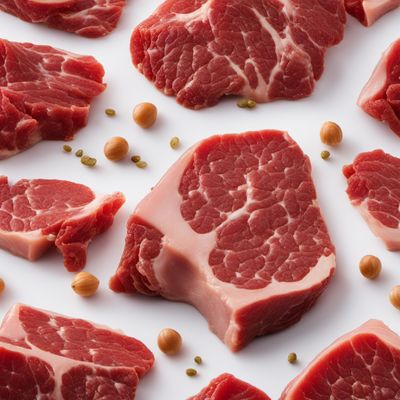
Ingredient
Bovine liver
The Nutrient Powerhouse: Bovine Liver
Bovine liver is a dark reddish-brown organ meat with a dense and firm texture. It has a robust and slightly metallic taste, often described as earthy or gamey. The liver is known for its high nutrient content, including vitamins A, B12, and iron. It can be cooked in various ways, such as pan-frying, grilling, or incorporating it into stews and pâtés.
Origins and history
The consumption of liver dates back to ancient times, where it was highly valued for its nutritional benefits. Bovine liver has been a staple in many traditional cuisines around the world, including European, Asian, and African cuisines. It has been used in dishes like liver and onions, liver pâté, and liver dumplings. In some cultures, liver is considered a delicacy and is often served during special occasions or festive celebrations.
Nutritional information
Bovine liver is a nutrient powerhouse, rich in vitamins A, B12, and iron. It is also a good source of protein and other essential minerals. However, it is high in cholesterol, so it should be consumed in moderation as part of a balanced diet.
Allergens
Some individuals may be allergic to liver or have sensitivities to its strong flavor. It is recommended to consult with a healthcare professional if you have any concerns or known allergies.
How to select
When selecting bovine liver, choose fresh liver that has a deep red color and a smooth surface. Avoid liver that appears discolored, has a strong odor, or shows signs of spoilage. It is best to purchase liver from a reputable source, such as a trusted butcher or a reliable supermarket.
Storage recommendations
To maintain the freshness of bovine liver, store it in the refrigerator at a temperature below 40°F (4°C). It is best to use it within 1-2 days of purchase. If you need to store it for a longer period, you can freeze it. Wrap the liver tightly in plastic wrap or place it in an airtight container before freezing.
How to produce
Bovine liver is produced by raising cattle for meat. It is important to ensure that the cattle are raised in a healthy and humane environment, free from antibiotics and hormones. Proper feeding and care contribute to the quality of the liver.
Preparation tips
Before cooking bovine liver, it is recommended to soak it in milk or water for a few hours to reduce its strong flavor. This step also helps to tenderize the meat. Bovine liver can be pan-fried with onions, grilled, or used as an ingredient in stews, pâtés, or sausages. It pairs well with flavors like bacon, onions, and herbs like thyme or rosemary.
Substitutions
Chicken liver, pork liver, or lamb liver can be used as substitutes for bovine liver. They offer a similar flavor and texture, although they may have slight variations. However, if you prefer a milder taste, you can substitute with chicken breast or tofu for a vegetarian option.
Culinary uses
Bovine liver is commonly used in dishes like liver and onions, liver pâté, liver dumplings, and liverwurst. It is also used as an ingredient in traditional dishes like haggis, foie gras, and liver curry. Liver is often incorporated into various cuisines around the world, adding depth and richness to the dishes.
Availability
Bovine liver is commonly available in many countries around the world, particularly in regions where beef is a staple meat. It can be found in supermarkets, butcher shops, and local markets. However, availability may vary depending on the region and cultural preferences.

